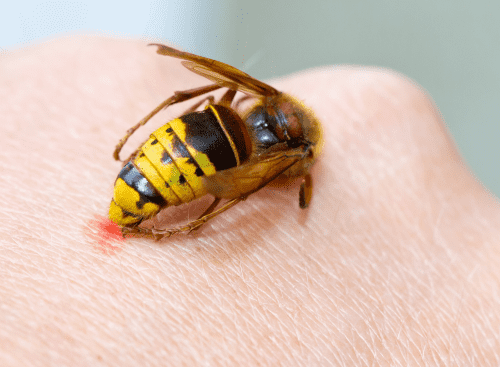Is A Bee Sting Acidic Or Alkaline, And What About Wasp Stings?
The motive for asking this question is often related to treating a bee or wasp sting.
Many are familiar with the old adage: ‘bee stings are acidic so treat them with baking soda (an alkali), but wasp stings are alkali so treat them with vinegar (an acid)'.
But can baking soda really neutralize a bee sting, and will splashing vinegar on a wasp sting actually help?
Let's investigate!
What is the pH of bee sting and wasp sting venom?
The short answer is:
Bee stings are mildly acidic (and wasp stings are close to neutral).
Acidity / alkalinity is measured and referred to by what is known as the pH scale (pH stands for ‘power of Hydrogen). The scale goes from 0 (highly acidic – e.g. battery acid) to 14 (highly alkaline – e.g. liquid drain cleaner), with pH 7 being neutral.
To give you some idea of the pH values of some well known substances, here’s a list with a comparison of where bee and wasp venom sit within the pH scale:
As can be seen from the table above, bee sting venom has a pH between 4.5 and 5.5 (1) – so it is acidic, although not highly acidic (and only slightly more acidic than milk and human saliva).
Wasp venom is close to neutral – pH 6.8 – so it is not so alkali as many people may think!
What does this mean if we want to answer the question about using baking soda for bee stings, and vinegar for wasp stings as mentioned above, and given the reality that bee stings are only mildly acidic, and wasp stings are more or less neutral, and both are injected into the skin not onto the skin.
I cannot find any direct scientific research (on humans) for the efficacy of either remedy.
That said, unless I was experiencing a very severe reaction I might give them a try!
Absence of evidence is not the same as 'evidence of inefficacy', and there are recommendations from reputable sources that advocate both bicarbonate of soda and vinegar as natural remedies, albeit in different scenarios.
Bicarbonate of soda
The Centre For Disease Control recommends baking soda for mosquito bites to reduce an itch response. They provide a recipe of 1 tablespoon baking soda with a little water added to create a paste, which they state should be applied to a bite for 10 minutes before being washed off.
Vinegar
I have read contributions on forums from members of the public, suggesting that some relief of wasp sting reactions was gained from vinegar.
Furthermore, immediate vinegar application at the site of box jellyfish stings is practiced at various coastal locations around the world because vinegar deactivates the nematocysts2 - but not for stings from all jellyfish (it would be important to be sure of species).
Vinegar (acetic acid) is also used for some coral stings and dermatitis caused by a number of species of marine sponge3.
There are other kitchen cupboard sting remedies that can be tried.
Conventional treatments for dealing with bee and wasp stings
Bee stings can be painful and can lead to other problems such as inflammation, or allergy (sometimes severe allergy), but there are some things that you could do to alleviate the symptoms caused by bee stings.
- Ice to reduce swelling and inflammation
The ice will also reduce blood flow away from the sting, so reducing the flow of venom to the rest of the body. As a precaution do not put the ice directly onto the skin, which may lead to ice burns, but wrap the ice in something such as a cloth before placing that on the skin. - Antihistamine spray or cream / ointment
This will also help reduce inflammation and hopefully prevent any local allergic reaction to the sting. Check whether antihistamines are appropriate for you before taking. - A local anaesthetic spray or cream
This could also help to relieve the pain from the sting. - Remove the stinger if from a honey bee
Honey bee stingers can get left behind in the skin following a stinging incident. Before treating, scrape away the stinger with a blunt ruler or similar blunt instrument.
References
(1) Ali, Mahmoud. (2012). Studies on Bee Venom and Its Medical Uses. International Journal of Advancements in Research & Technology. 1. 69-83.
(2)Johnston CS, Gaas CA. Vinegar: medicinal uses and antiglycemic effect. MedGenMed. 2006;8(2):61. Published 2006 May 30.
(3) Bansal, Mansi & Budhiraja, Umesh & Bansal, Himanshu. (2020). Contemporary pursuits of vinegar from scullery to dermatology. International Journal of Research in Dermatology. 6. 10.18203/issn.2455-4529.IntJResDermatol20203539.
Bee sting reactions
A description of possible reactions and what to do
If you found this page helpful or interesting, I'd really be grateful if you would share it with others - if not this page, perhaps another, such as Gardening For Bees.
Thank you so much :) .
